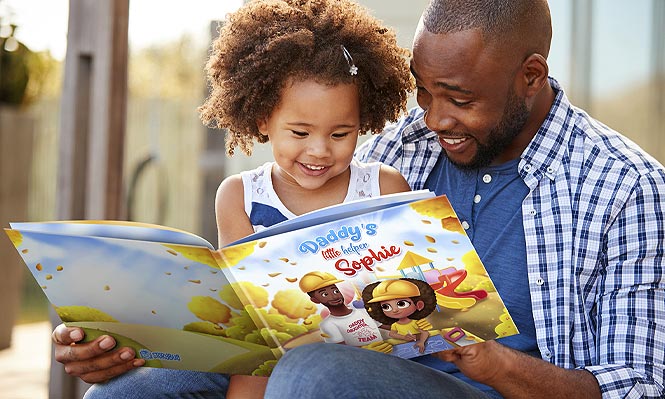10% Off Your First Order
Be first to know about new stories and offers
Balancing Screen Time: Integrating Physical Books into Your Child’s Entertainment

Is your child's screen time outpacing their book time? In today's digital world, we face a growing challenge: balancing screen time with the timeless value of physical books for children. As parents, we're navigating uncharted waters, trying to foster digital well-being while nurturing a love for traditional reading.
The stats are eye-opening. Kids aged 8-12 spend over 4 hours daily glued to screens, while even preschoolers' screen time has skyrocketed to more than 2 hours a day. This surge in digital consumption raises concerns about our children's development and learning potential.
But don't worry! We're here to explore practical ways to create a healthy mix of digital and physical reading experiences. By integrating physical books into your child's entertainment routine, you can help them reap the benefits of both worlds.
The digital age has transformed how kids interact with information. We're seeing a shift in reading habits for kids as screens become more prevalent in their daily lives. Digital age literacy now encompasses both traditional reading skills and the ability to navigate digital platforms.
Tablets, smartphones, and e-readers have become common in households. This increase in screen time for kids has changed how they consume content. Many children now read e-books or use educational apps, blending entertainment with learning.
With easy access to digital content, reading behavior is evolving. Kids often prefer shorter texts and interactive stories. While this can boost engagement, it may impact attention spans and deep reading skills.
Despite the digital shift, traditional reading skills remain important. Physical books offer unique benefits that screens can't replicate. Balancing screen time with book reading helps develop well-rounded literacy skills.
"Reading is to the mind what exercise is to the body." - Joseph Addison
We must guide children to embrace both digital and traditional reading. This balance ensures they develop the comprehensive literacy skills needed to thrive in our increasingly digital world.
Screen time management is crucial for children's well-being. We live in a digital world where screens are unavoidable, but finding the right balance is key. Educational screen time can boost learning and development, reinforcing classroom lessons and developing critical thinking skills.
Mindful technology use allows children to explore personalized learning experiences. Digital tools can adapt to individual needs, making education more engaging and effective. Yet, we must be cautious about recreational screen use.
Excessive recreational screen use can lead to:
The American Academy of Pediatrics suggests limiting recreational screen time to 1-2 hours daily for school-aged children. This guideline helps maintain a healthy balance between digital and real-world experiences. By practicing mindful technology use, we can harness the benefits of screens while minimizing potential drawbacks.
Physical books for children play a crucial role in shaping young minds. We've seen how these traditional reading materials offer unique benefits that digital alternatives can't match. Let's explore why incorporating physical books into kids' reading habits is essential for their growth.
Reading physical books engages multiple senses, enhancing information retention. Kids develop stronger vocabulary and critical thinking skills as they flip through pages. This tactile experience creates a more immersive learning environment, fostering cognitive development in ways screens can't replicate.
Shared reading experiences with physical books create special bonds between parents and children. These moments of connection go beyond just words on a page. They provide opportunities for discussion, empathy, and emotional growth. Family reading time becomes a cherished ritual, strengthening relationships and social skills.
Introducing physical books early on helps cultivate a lasting love for reading. Children who grow up surrounded by books often develop positive reading habits for kids that persist into adulthood. This foundation sets them up for success in school and beyond.
By embracing physical books alongside digital resources, we give our children the best of both worlds. This balanced approach to literacy ensures they develop well-rounded skills for the future while enjoying the timeless pleasure of a good book in their hands.
We all need a break from screens sometimes. Creating tech-free zones at home can help us embrace digital detox and foster a love for reading. Let's explore how to set up cozy reading nooks and encourage screen-free activities for the whole family.
Start by designating specific areas in your home as reading sanctuaries. Pick a quiet corner, add some comfy cushions, and voila! You've got a perfect spot for diving into a good book. Make these spaces inviting and free from digital distractions.
Establish reading rituals to make the most of your new sanctuaries:
Plan unplugged adventures to complement your at-home reading time. Visit the local library, go on nature hikes, or try hands-on science experiments. These screen-free activities spark curiosity and show kids that learning happens beyond digital boundaries.
By creating these tech-free zones and embracing screen-free activities, we're not just promoting reading. We're cultivating a balanced lifestyle that values both digital and traditional forms of entertainment and learning.

Finding the right balance between screen time and other activities can be a challenge for parents. We've gathered some effective strategies to help you manage your child's digital exposure while promoting a healthy lifestyle.
Establishing screen time limits is crucial for your child's well-being. Consider your child's age and maturity level when setting boundaries. For younger children, aim for shorter periods of screen time, gradually increasing as they grow older. Use parental controls to ensure they access age-appropriate content during their allotted time.
Encourage a diverse range of activities to balance screen time. Introduce outdoor play, reading physical books, or family game nights as engaging alternatives. Create a consistent schedule that includes both online learning and offline activities. This approach fosters a well-rounded development and prevents excessive reliance on digital devices.
Children often mimic their parents' behavior. Practice mindful device usage by limiting your own recreational screen time. Show your kids the importance of face-to-face interactions and outdoor activities. By modeling healthy screen habits, you set a positive example for your children to follow.
"The best way to teach our children about balanced technology use is to demonstrate it ourselves."
Remember, the goal is not to eliminate screen time entirely but to foster a healthy relationship with technology. By implementing these strategies, you can help your child develop good habits and enjoy the benefits of both digital and traditional activities.
We believe that fostering reading habits for kids is crucial in today's digital world. By incorporating physical books for children into daily routines, we can nurture a love for reading that lasts a lifetime.
Start by building a diverse collection of books that align with your child's interests. Include a mix of fiction and non-fiction titles to cater to different moods and learning styles. This variety will keep your little ones engaged and excited about reading.
Establish a dedicated reading time each day. This could be before bedtime, after school, or during a quiet afternoon hour. Consistency is key in developing strong reading habits for kids.
Make storytelling interactive by encouraging your children to act out their favorite scenes. This brings stories to life and enhances comprehension. You can even create simple costumes or props using household items to add to the fun.
Design a cozy reading nook in your home. Fill it with comfortable seating, good lighting, and easily accessible bookshelves. This special space will make physical books for children more appealing and create positive associations with reading.
By weaving physical books into your family's daily life, you're not just promoting reading habits for kids, you're opening doors to new worlds and fostering a lifelong passion for learning.
Technology offers exciting ways to boost children's reading experiences. By using digital tools wisely, we can promote digital well-being while nurturing a love for books. Let's explore how tech can enrich reading for kids.
Reading apps bring stories to life through animation, sound effects, and touch-responsive elements. These features captivate young readers and make storytelling more engaging. E-books offer adjustable text sizes and built-in dictionaries, making reading more accessible for all.
Digital tools help monitor reading habits and set achievable goals. Apps can track pages read, time spent reading, and comprehension levels. This data empowers parents and children to celebrate milestones and identify areas for improvement.
Virtual book clubs and reading platforms connect young readers worldwide. These communities foster discussions, encourage book recommendations, and create a sense of belonging among bookworms. They promote mindful technology use by focusing on meaningful interactions around literature.
By embracing these tech-driven reading enhancements, we can create a balanced approach to literacy in the digital age. The key is to use technology as a tool to supplement, not replace, traditional reading methods. This strategy supports both digital well-being and a lifelong love for books.
Libraries and bookstores are changing with the times. They're finding new ways to keep people interested in reading physical books while balancing screen time. These places are becoming more than just spots to borrow or buy books.
We're seeing libraries offer e-book lending services alongside their regular books. This mix helps readers enjoy both digital and physical books. Bookstores are creating fun spaces where kids can explore and get excited about reading.
Many libraries and bookstores now host story times, meet-the-author events, and reading challenges. These activities get kids excited about physical books for children. They make reading a fun, shared experience that screens can't always provide.
By offering both digital and physical resources, libraries and bookstores are helping families find the right balance. They're showing us that there's room for both screens and paper pages in our reading lives. This blend supports optimal learning and keeps the love of books alive in the digital age.
 Girls Books to Inspire and Empower..
For young girls, seeing themselves represented as the protagonist in a story can have an enormous impact.
Jan 9, 2023
Girls Books to Inspire and Empower..
For young girls, seeing themselves represented as the protagonist in a story can have an enormous impact.
Jan 9, 2023
 Personalized Books as Gifts..
Have you ever received a gift that made your heart swell with warmth and love?
May 13, 2023
Personalized Books as Gifts..
Have you ever received a gift that made your heart swell with warmth and love?
May 13, 2023
 Learning the Alphabet..
According to research, children are 53% more likely to retain information..
July 11, 2024
Learning the Alphabet..
According to research, children are 53% more likely to retain information..
July 11, 2024